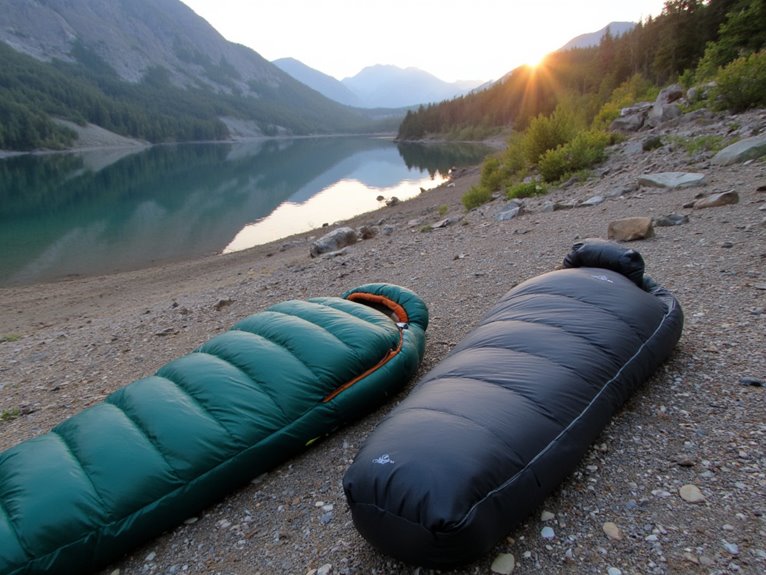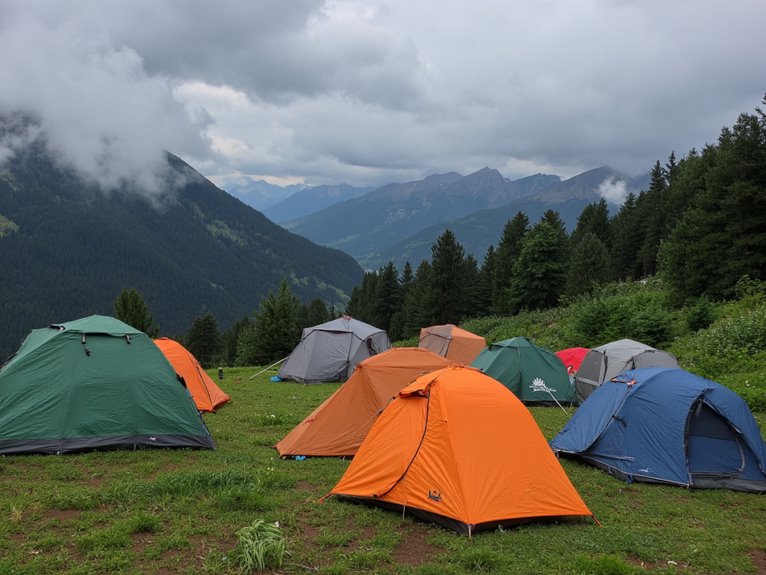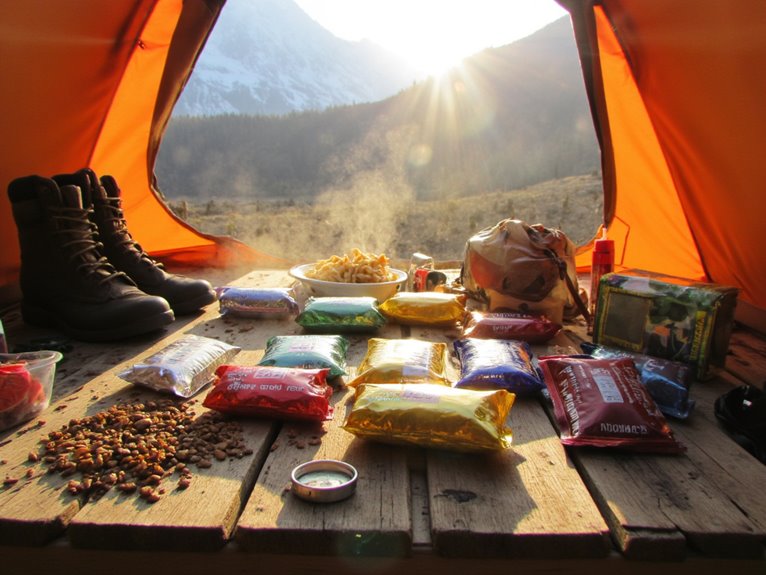What Is the Best Shower Set up for Overlanding?
In the realm of overlanding, a reliable and efficient shower setup is essential. Rooftop-mounted shower systems offer a compact and lightweight design, while portable shower tents provide a waterproof and bug-free space. Solar shower bags harness the sun's energy to heat water, making them an eco-friendly and cost-effective option. Water conservation strategies, such as low-flow showerheads and shower timers, can also help minimize water usage. By considering factors like space, comfort, and hygiene, overlanders can create a shower setup that meets their unique needs. Investigate the various options and strategies to find the perfect balance for your next adventure.
We are supported by our audience. When you purchase through links on our site, we may earn an affiliate commission, at no extra cost for you. Learn more. Last update on 7th January 2026 / Images from Amazon Product Advertising API.
Rooftop-Mounted Shower Systems
Rooftop-mounted shower systems, which typically consist of a water tank, pump, and showerhead, offer a convenient and space-saving solution for overlanders who need a reliable and self-contained showering setup while on the go.
These systems are designed to be compact and lightweight, making them ideal for overlanding vehicles with limited storage capacity.
The water tank is usually refillable, and the pump provides a consistent water pressure, guaranteeing a comfortable showering experience.
Rooftop-mounted shower systems are also relatively easy to install and maintain, with many models featuring quick-connect fittings and adjustable showerheads.
Portable Shower Tents Reviewed
For overlanders who require a more private and enclosed showering experience, portable shower tents offer a versatile and convenient solution that can be easily set up in a variety of outdoor environments.
These tents provide a waterproof and bug-free space to shower, making them ideal for camping in wet or buggy conditions.
When selecting a portable shower tent, consider factors such as waterproof rating, floor space, and weight.
Look for tents with durable materials, sturdy frames, and easy assembly.
Some popular options include the REI Co-op Shower Tent and the WolfWise Pop-Up Shower Tent.
Both offer excellent water resistance and ample interior space.
When paired with a portable shower head and water source, these tents provide a comfortable and private showering experience on the go.
Solar Shower Bags Explained
When venturing into solar shower bags, there are several key factors to examine to guarantee a reliable and efficient showering experience while overlanding.
Three essential aspects to evaluate are portable water heating capabilities, the level of insulation and durability of the bag, and the various water capacity options available.
Portable Water Heating
In the domain of portable water heating, solar shower bags have emerged as a game-changer for overlanders, offering a convenient, eco-friendly, and cost-effective way to enjoy a rejuvenating shower in the great outdoors.
These innovative bags use the sun's energy to heat water, providing a revitalizing shower experience even in remote areas.
Some key benefits of solar shower bags include:
- Lightweight and compact design, making them easy to transport and store
- Easy to use, simply fill the bag with water and leave it in direct sunlight
- Environmentally friendly, reducing reliance on fossil fuels and minimizing waste
Insulation and Durability
A well-designed solar shower bag's insulation and durability are critical components that substantially impact its overall performance, as they directly affect the temperature of the water and the lifespan of the product.
Insulation is vital in maintaining the water temperature, ensuring a comfortable showering experience. Look for solar shower bags with thick, high-density insulation that can retain heat efficiently.
Durability is also essential, as it determines how well the bag can withstand the rigors of overlanding. A durable solar shower bag should be made from heavy-duty materials that can resist punctures, tears, and abrasion.
A well-insulated and durable solar shower bag will provide a reliable and enjoyable showering experience during your overlanding adventures.
Water Capacity Options
Solar shower bags come in a variety of water capacity options, ranging from compact 2-gallon bags ideal for solo travelers to larger 5-gallon bags suitable for families or groups, allowing overlanders to choose the right size for their specific needs.
When selecting a solar shower bag, it's essential to think about the number of people who will be using the shower, as well as the duration of the trip.
Some key factors to bear in mind when choosing a water capacity option include:
- Water conservation: smaller bags encourage water-saving habits
- Space constraints: compact bags are ideal for small vehicles or tight storage spaces
- Group size: larger bags accommodate multiple users, reducing wait times and increasing convenience
Water Conservation Strategies
Optimizing water usage is essential for overlanders, as every gallon counts when venturing off the grid, and implementing effective water conservation strategies can substantially extend the duration between refills.
One key strategy is to install low-flow showerheads, which can reduce water consumption by up to 50%.
Additionally, incorporating a shower timer or a pause valve can help reduce water waste and encourage shorter showers.
Another approach is to incorporate a water-recirculating system, which allows for the reuse of water that would otherwise be lost.
Off-Grid Water Heating Options
When venturing off the grid, access to a reliable and efficient water heating system is vital for a comfortable and convenient showering experience. Off-grid water heating options are designed to provide hot water in remote areas where traditional connections are not available.
There are several options to weigh, including:
- Propane-powered water heaters: These systems use propane to heat water, providing a reliable source of hot water even in remote areas.
- Solar shower bags: These innovative bags use the sun's energy to heat water, making them an eco-friendly and cost-effective option.
- Instant hot water heaters: These systems heat water only as needed, reducing energy consumption and providing a convenient and efficient showering experience.
These off-grid water heating options guarantee that you can enjoy a hot shower, even in the most remote locations.
Showering With Limited Water
When showering with limited water, every liter counts.
To make the most of this precious resource, it's essential to adopt water-saving habits and invest in low-flow shower options.
Water Conservation Tips
In the context of overlanding, where water is a precious commodity, adopting water-conserving showering habits is essential to minimize waste and stretch limited resources. Every liter counts when you're off the grid, and implementing simple yet effective water-saving strategies can make a significant difference.
Turn off the water while soaping up: This simple habit can save up to 20 liters of water per shower.
Use a bucket to catch excess water: Collect and reuse water for other purposes, such as washing dishes or rinsing gear.
Take 'Navy showers': Wet yourself, turn off the water, lather up, and then rinse off quickly to minimize water usage.
Low-Flow Shower Options
To further minimize water waste while showering off the grid, low-flow shower options can drastically reduce water consumption, making them a vital component of a well-planned overlanding setup.
These showerheads typically use 2 gallons per minute or less, substantially reducing water waste.
Look for showerheads with a WaterSense label, which indicates they meet EPA standards for water efficiency.
Some popular low-flow shower options include handheld showerheads, which allow for targeted washing and reduce water usage.
Other options include showerheads with built-in flow restrictors or those that use air-infused technology to reduce water flow while maintaining pressure.
Towel-Drying and Changing Areas
A dedicated towel-drying and changing area is essential for maintaining personal hygiene and comfort during overlanding adventures, as it provides a private and convenient space to dry off and change clothes after a shower.
This area should be designed to keep you warm, dry, and comfortable, even in harsh outdoor conditions.
Some key considerations for an effective towel-drying and changing area include:
A waterproof and windproof enclosure to protect against the elements
A sturdy and slip-resistant floor to prevent accidents
Ample storage for towels, clothes, and personal items to keep them dry and within reach
Hygiene in Remote Areas
Remote wilderness areas often lack access to basic sanitation facilities, making personal hygiene a paramount aspect of overlanding adventures that requires careful planning and creative solutions.
In remote areas, maintaining personal hygiene is essential to prevent the spread of illnesses and maintain overall health.
Overlanders should prioritize handwashing, using hand sanitizer or biodegradable soap when water is scarce. It's also essential to dispose of human waste properly, using portable toilets or digging shallow holes at least 200 feet away from water sources.
Proper hygiene practices will safeguard a healthy and enjoyable overlanding experience. By adopting these habits, overlanders can minimize their environmental impact while maintaining their personal health and well-being.
Camp Shower Accessories Needed
Personal hygiene practices in remote areas can be substantially improved with a well-equipped camp shower setup, which requires a few specialized accessories to guarantee a rejuvenating and sanitary shower experience.
A well-stocked camp shower setup should include the following essential accessories:
- Water containers: Collapsible water tanks or portable water containers to store and transport water for showering
- Shower mats: Anti-slip mats or shower trays to prevent slipping and provide a clean showering surface
- Shower curtains: Waterproof curtains or enclosures to provide privacy and contain water spray
These accessories will facilitate a comfortable and hygienic shower experience even in the most remote areas, thereby promoting a refreshing and sanitary showering environment.
Budget-Friendly Shower Solutions
Opting for budget-friendly shower solutions can substantially reduce the financial burden of overlanding, allowing adventurers to allocate resources to other essential aspects of their journey.
One cost-effective option is a portable shower bag, which can be filled with warm water and hung from a tree or pole, providing a rejuvenating rinse.
Another affordable solution is a solar shower, which uses the sun's energy to heat water.
For a more permanent setup, consider a DIY shower enclosure made from a tarp and PVC pipes.
These budget-friendly options enable overlanders to prioritize their spending on other vital aspects of their trip, such as food, fuel, and camping fees.




